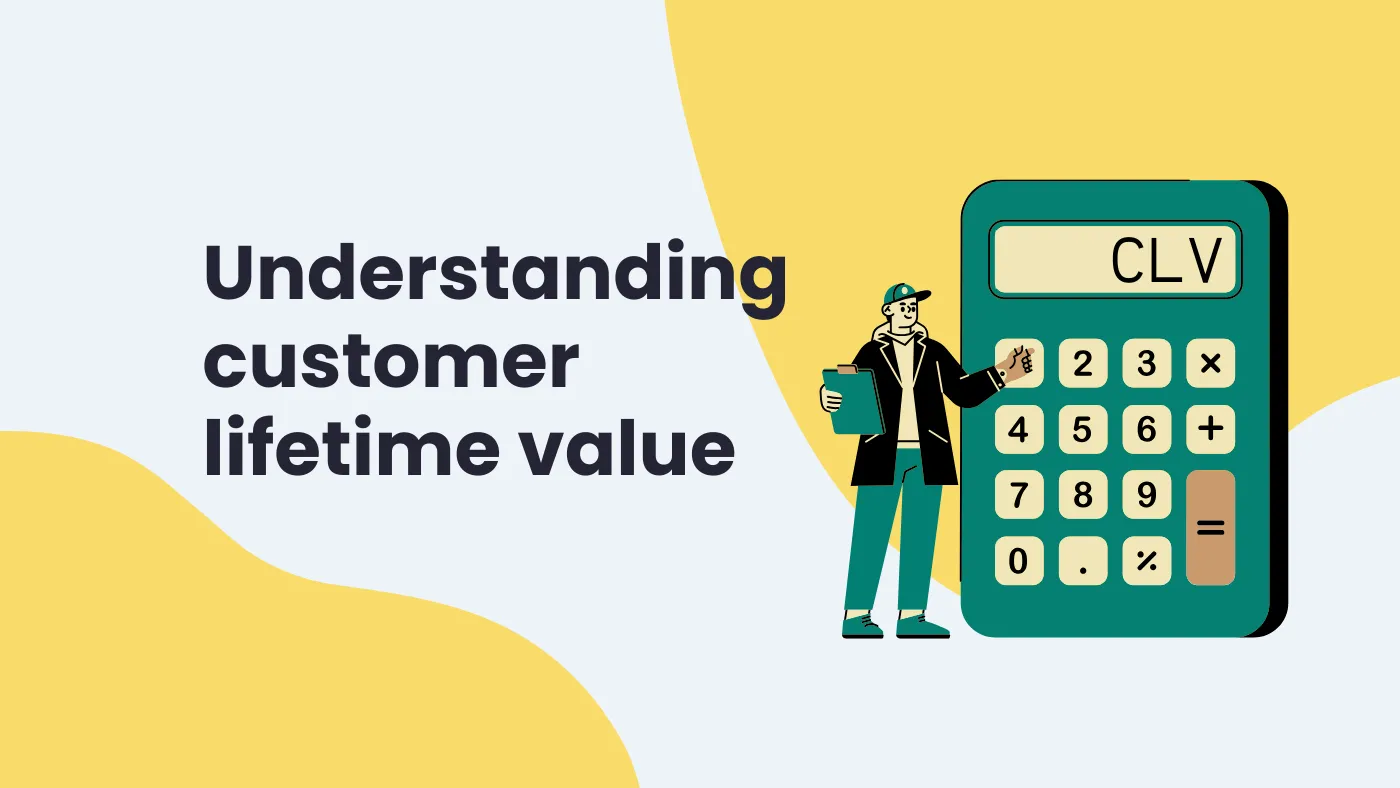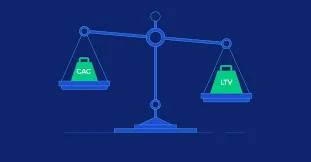Did you know that boosting customer retention by a mere 5% can amplify profits by 25% to 95%? (Harvard Business Review). That’s the power of understanding Customer Lifetime Value (CLV).
Every business wants more revenue, lower costs, and loyal customers. But without knowing how much a customer is worth over time, you could be losing money without realizing it. That’s where the LTV formula called customer lifetime value comes in.
This guide will help you calculate CLV step by step, break down customer acquisition cost (CAC) vs. retention, and reveal strategies to increase high-value customers.
Whether you're a startup or an established brand, knowing your CLV helps you make data-driven decisions to improve profit margins and future revenue.
What is Customer Lifetime Value?

Customer Lifetime Value (CLV) shows how much revenue a business earns from a single customer over time. It helps companies decide how much to spend on customer acquisition cost and marketing efforts.
To calculate CLV, businesses use the LTV formula lifetime value method. This considers factors like average revenue, purchase frequency, and customer retention rates.
Customer Lifetime Value Calculation

1. Determine the Average Purchase Value
The average purchase value shows how much a customer spends per transaction.
How to calculate:
- Add up the total revenue earned over a specific period.
- Divide it by the total number of purchases during that time.
Formula: Average Purchase Value = Total Revenue ÷ Total Purchases
For example, if your business made $50,000 in total revenue from 1,000 purchases, then: $50,000 ÷ 1,000 = $50 per purchase
2. Calculate the Average Purchase Frequency
This tells you how often a customer buys from you.
How to calculate:
- Divide the total number of purchases by the total number of unique customers.
Formula: Average Purchase Frequency = Total Purchases ÷ Total Customers
Example: If you had 1,000 purchases and 500 customers, then: 1,000 ÷ 500 = 2 purchases per customer
Customers who buy more often increase their customer lifetime value and repeat business.
3. Determine the Customer Value
Customer value tells you how much revenue an average customer generates.
How to calculate:
- Multiply the average purchase value by the average purchase frequency.
Formula: Customer Value = Average Purchase Value × Average Purchase Frequency
Example: Suppose the average purchase value is $50, and the average purchase frequency rate is 2. In that case, the customer value would be calculated as $50 multiplied by 2, resulting in $100 per customer.
This helps you measure future revenue and find high-value customers.
4. Identify the Average Customer Lifespan
The average value of customer lifespan is how long a customer stays with a business before they stop buying. It is an important factor in customer lifetime value calculation.
How to Calculate:
- Pick a time period (e.g., 3 years).
- Count the number of loyal customers at the start and end.
- Find the average number of years a customer stays.
For example, if most customers buy for 5 years, that’s your average per customer lifecycle lifespan. Businesses with higher customer retention rates usually have a longer lifespan.
5. Calculate Customer Lifetime Value (CLV)
CLV tells you how much a customer is worth over time. It helps businesses make better decisions about customer acquisition costs and marketing efforts.
How to Calculate:
Use the LTV formula lifetime value:
CLV = (Average Purchase Value × Purchase Frequency) × Average Customer Lifespan
- Average purchase value: Total revenue ÷ total purchases.
- Purchase frequency: How often a customer buys per year.
- Average customer lifespan: The number of years a customer stays.
For example, if a customer spends $50 per purchase, buys twice a year, and stays for 5 years, their CLV = (50 × 2) × 5 = $500.
6. Adjust for Gross Margin (Optional)
Not all revenue is profit. Some of it covers costs like acquisition costs and customer onboarding. Adjusting measure revenue for profit margins gives a clearer customer lifetime value.
How to Calculate:
Multiply CLV by the gross margin percentage: Adjusted CLV = CLV × GrossMargin
If your gross margin is 40%, then: Adjusted CLV = 500 × 0.4 = $200
This helps businesses see net profit and make smart investment choices.
How to Improve Customer Lifetime Value

1. Use Cohort Analysis for Precision
Cohort analysis helps businesses group customers based on their behaviors. This allows companies to track customer retention rates, repeat business, and average customer lifespan more accurately.
How to use it:
- Identify different customer segments based on purchase patterns.
- Compare loyal customers with those who leave early (churn).
- Adjust marketing efforts to keep high-value customers longer.
Example: If new customers from ads stop buying after 3 months, but referrals stay for a year, focus on referral strategies to get high-value customers.
2. Enhance Customer Experience to Reduce Churn
Happy customer continues, customers stay longer, spend more, and refer others. A poor customer experience leads to churn rate increase.
How to improve it:
- Offer personalized support during the customer onboarding process.
- Use customer feedback to fix pain points and improve service.
- Keep communication clear, fast, and helpful.
Example: If customers leave due to slow responses, setting up chat support can increase engagement and customer retention rates.
3. Implement Subscription or Loyalty Programs
Loyalty programs encourage current customers to return and buy more. Subscriptions create steady revenue and increase future cash flows.
How to set them up:
- Offer discounts or loyalty programs for frequent buyers.
- Provide exclusive benefits to best customers who make high-value purchases.
- Reward referrals to bring in new customers while keeping current ones engaged.
Example: A coffee shop offering a “Buy 9, Get 1 Free” deal increases purchase frequency and customer lifetime value calculation.
4. Improve Customer Engagement with Personalized Marketing
Customers want products and offers that fit their needs. Personalization makes customers feel more valued, boosting brand loyalty and repeat business.
How to personalize marketing:
- Send emails based on customer purchase history.
- Use AI recommendations for relevant products.
- Offer special deals to existing customers based on past spending.
Example: If a customer buys baby products, sending emails about baby care discounts can improve customer retention, decrease spending, and increase repeat business.
How to Target the Right Customer Segments for High LTV

1. Analyze Your Existing High-Value Customers
High-value customers are those who bring the most profit over time. They have a high purchase frequency, average order value, revenue, and brand loyalty.
How to analyze them:
- Check past data to see which customers buy often.
- Look at customer retention rates to find those who stay the longest.
- Compare spending habits of best customers vs. others.
2. Use RFM Analysis (Recency, Frequency, Monetary Value)
RFM analysis groups customers based on:
- Recency – When was their last purchase?
- Frequency – How often do they buy?
- Monetary Value – How much do they spend?
How to use it:
- Find loyal customers who buy frequently and spend more.
- Identify new customers who show potential.
- Offer special deals to high-value customer segments to keep them engaged.
3. Segment Based on Customer Behavior
Behavior-based segmentation helps target customers by their habits. Businesses can improve marketing efforts, customer experience, and total revenue this way.
How to do it:
- Divide customers by purchase history, preferences, and feedback.
- Personalize offers based on customer onboarding and engagement.
- Use future cash flows to predict who will spend more.
4. Target the Right Acquisition Channels
Not all marketing channels bring high-value customers. Some attract new customers who buy once and never return. Others bring in loyal customers who generate repeat business.
How to do it:
- Track which channels bring customers with high customer lifetime value.
- Compare the customer acquisition cost (CAC) across different platforms.
- Focus on sources that bring best customers with high purchase frequency.
5. Prioritize Value-Based Selling
Value-based selling means focusing on customer needs rather than just the product. It increases brand and customer loyalty, future revenue, and retention rates.
How to do it:
- Understand what customer segments value most.
- Personalize offers based on their needs.
- Show how your product solves problems, rather than just listing features.
6. Optimize Pricing and Upselling Strategies
Pricing and upselling help businesses increase customer lifetime value. Customers who spend more over time contribute to higher net profit.
How to do it:
- Offer tiered pricing to capture high-value customers.
- Upsell relevant products based on purchase frequency.
- Use discounts for existing customers to encourage repeat business.
7. Focus on Post-Purchase Retention
Getting a customer is just the first step. Keeping them is what drives repeat business and future revenue. A good post-purchase strategy ensures customers stay engaged.
How to do it:
- Offer fast and friendly customer onboarding.
- Send personalized thank-you messages and follow-up emails.
- Use customer feedback to improve their experience.
8. Leverage AI and Predictive Analytics
AI helps businesses understand their entire customer base and predict future buying habits. It improves marketing efforts and personalizes offers.
How to use it:
- Identify best customers based on past data.
- Predict churn rate and offer deals to keep customers engaged.
- Automate personalized recommendations to increase repeat business.
Customer Acquisition Cost (CAC) and Its Impact on LTV

Customer Acquisition Cost (CAC) is the money a business spends to gain a new customer. This includes marketing, advertising, and sales expenses.
A high CAC can lower profits if not managed well. That’s why businesses must compare CAC with customer lifetime value (CLV) to make smart decisions.
To calculate CAC, use this formula:
CAC = Total Marketing and Sales Expenses/ Number of New Customers Acquired
For example, if a company spends $10,000 on marketing and gains 500 new customers, the CAC is $20 per customer. If those customers only generate $15 in revenue, the company is losing money.
A good LTV to CAC ratio is 3:1, meaning a customer should bring in at least three times what it costs to acquire them.
Businesses can improve this by increasing customer lifetime value, reducing churn rate, and encouraging repeat business.
Common Pitfalls When Calculating Lifetime Value
1. Using a One-Size-Fits-All Formula
Many businesses use a basic LTV formula without considering different customer types. Not all customers spend the same amount, buy at the same frequency, or stay for the same time.
How to avoid it:
- Segment customers based on purchase frequency, spending habits, and retention rates.
- Use customer segments to adjust lifetime value calculation for different groups.
- Compare best customers, repeat business, and average purchase value to get a clear picture.
Example: A subscription-based company has loyal customers who stay for years and others who cancel after a month. Using one formula for both can mislead marketing efforts and waste acquisition costs.
2. Ignoring Customer Acquisition Costs (CAC)
A business might think it has high customer lifetime or lifetime customer value, but if customer acquisition cost (CAC) is too high, it might actually lose money.
How to avoid it:
- Always compare LTV vs CAC to measure profit margins.
- Aim for an LTV to CAC ratio of 3:1 to keep future revenue and cash flows healthy.
- Lower acquisition costs by focusing on customer retention, onboarding, and repeat business.
Example: If a company spends $100 to acquire a customer but earns only $80 from them, they are losing money. Tracking customer retention rates and purchase frequency can help reduce churn rate and improve net profit.
3. Assuming a Fixed Customer Lifespan
Many businesses assume customers will stay for a particular segments or certain customer segments or set number of years. In reality, customer retention rates, purchase frequency, and brand loyalty can change over time.
How to avoid it:
- Track customer relationships and behavior instead of using a fixed number.
- Adjust lifetime value calculations based on real purchase data and future revenue trends.
- Monitor loyal customers and high-value customers to see how long they actually stay.
Example: A gym owner might assume customers stay for two years, but in reality, many cancel after six months. This miscalculates potential customer lifetime value and affects profit margins.
4. Not Accounting for Churn Rate
Churn rate is the percentage of customers who stop doing business with you. Ignoring it inflates LTV calculations and leads to unrealistic revenue expectations.
How to avoid it:
- Track churn rate to measure customer retention rates.
- Focus on customer onboarding, loyalty programs, and retention strategies to reduce churn.
- Adjust LTV formula lifetime value by considering repeat business vs. lost customers.
Example: A SaaS company expects $500 per customer in lifetime value, but 30% of customers cancel within a year. Without considering churn, their projected revenue will be too high.
5. Failing to Adjust for Discounts and Returns
Many businesses calculate lifetime value based on total sales. But not all sales equal profit. Some customers use discounts, and others return products. If these are not accounted for, the LTV formula lifetime value may be overestimated.
How to avoid it:
- Subtract returns and refunds from total revenue.
- Track discounted purchases separately from full-price sales.
- Monitor repeat business and customer retention rates to see if discounted customers stay loyal.
Example: A clothing store sells $100,000 in one year. But $10,000 comes from discounts and $5,000 from returns. If the business ignores these, it overestimates revenue and profit margins.
Conclusion
Understanding customer lifetime value (CLV) is essential for making smart business decisions. It helps you measure future revenue, optimize acquisition costs, and improve customer retention.
Using the LTV formula to measure customer lifetime value, businesses can track high-value customers, repeat business, and profit margins. However, common mistakes—like ignoring churn rate, using a fixed customer lifespan, or failing to adjust for discounts—can lead to wrong calculations.
To maximize total revenue, focus on customer relationships, retention strategies, and loyalty programs. A strong customer experience and targeted strategies that inspire lifelong loyalty will increase customer lifetime and future cash flows.
By refining your lifetime value calculation, you ensure sustainable growth and long-term profitability.





.jpg)

.jpg)
